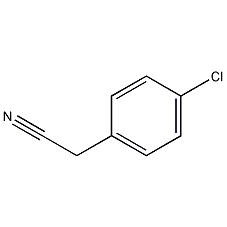p-Chlorobenzyl Cyanide 4-Chlorobenzyl Cyanide


Structural formula
| Business number | 03T4 |
|---|---|
| Molecular formula | C8H6ClN |
| Molecular weight | 151 |
| label |
4-Chlorophenylacetonitrile, 4-chlorobenzyl cyanide, p-chlorobenzyl cyanide, p-chlorobenzyl cyanide, (4-chlorophenyl)acetonitrile, Pesticide intermediates; aromatic halogen derivatives |
Numbering system
CAS number:140-53-4
MDL number:MFCD00001918
EINECS number:205-418-9
RTECS number:AL8250000
BRN number:971171
PubChem number:24892534
Physical property data
1. Properties: colorless to light yellow solid
2. Melting point (℃): 27
3. Boiling point (℃): 265~267
4. Flash point (℃): 110
5. Solubility: soluble in acetone and ethanol.
Toxicological data
1. Acute toxicity: Not reported in rats. LDLo: 1500 mg/kg;
Mouse abdominal LD50: 27 mg/kg;
Rat intravenous LD50: 56 mg/kg.
Ecological data
Other harmful effects: This substance may be harmful to the environment, and special attention should be paid to water bodies.
Molecular structure data
1. Molar refractive index: 40.61
2. Molar volume (cm3/mol): 127.5
3. Isotonic specific volume (90.2K ): 328.0
4. Surface tension (dyne/cm): 43.7
5. Polarizability (10-24cm3): 16.09
Compute chemical data
1. Reference value for hydrophobic parameter calculation (XlogP): None
2. Number of hydrogen bond donors: 0
3. Number of hydrogen bond acceptors: 1
4. Number of rotatable chemical bonds: 1
5. Number of tautomers: none
6. Topological molecule polar surface area 23.8
7. Number of heavy atoms: 10
8. Surface charge: 0
9. Complexity: 139
10. Number of isotope atoms: 0
11. Determine the number of atomic stereocenters: 0
12. Uncertain number of atomic stereocenters: 1
13. Determine the number of chemical bond stereocenters: 0
14. Number of uncertain chemical bond stereocenters: 0
15. Number of covalent bond units: 1
Properties and stability
1. Stable under normal temperature and pressure.
2.This product is highly toxic. It is highly irritating to the skin and eyes and has a tear-inducing effect. Ventilation should be strengthened in the workshop, equipment should be sealed, and protective equipment (such as goggles, gas masks, gloves, etc.) should be worn during operation. If it splashes on the skin, rinse it with ethanol.
Storage method
Store sealed in a dry and cool place.
Packed in iron drums or plastic drums. Store and transport according to regulations on highly toxic and dangerous goods.
Synthesis method
1. Obtained from the reaction of p-chlorobenzyl chloride and sodium cyanide. Add p-chlorobenzyl chloride and benzalkonium chloride to the reaction pot, heat to 100°C, slowly add sodium cyanide aqueous solution, and react at 100-104°C for 5 hours (add sodium cyanide for 3 hours, and keep warm for 2 hours). Then add water to dissolve the sodium chloride, and separate the water layer to obtain crude p-cyanobenzyl chloride. Distill under reduced pressure and collect 160 (2.66kPa) fractions to obtain the finished product. The yield is over 81%. This product can also be obtained by refluxing benzyl chloride and sodium cyanide in ethanol at 83-85°C for 4 hours. The industrial intermediate is a slightly yellow liquid containing ≥90% p-cyanobenzyl chloride. Raw material consumption quota: p-chlorobenzyl chloride (92%) 1432kg/t, sodium cyanide (95%) 450kg/t, and benzalkonium chloride (90% or more) 18kg/t.

2. The preparation method is to Add solid sodium cyanide and water to the reactor, heat to 40°C to dissolve the sodium cyanide, add a phase transfer catalyst, and then add benzyl chloride dropwise at a temperature of 40 to 60°C. After the dropwise addition, the temperature is 85°C. The reaction was stirred for 4 hours, cooled and processed to obtain p-cyanobenzyl chloride.
Purpose
1. Used as an intermediate of the drug pyrimethamine and in the synthesis of medicines and dyes.
2. p-Chlorocyanobenzyl, p-chlorophenylacetonitrile, is an intermediate for the preparation of 3-methyl-2-(4-chlorophenyl)butyric acid and can be used to prepare fenvalerate, bromide Pyrethroid insecticides such as methmethrin and can be used in the pharmaceutical industry to prepare pyrimethamine.
3. Intermediates of the drug pyrimethamine. Used to produce p-chlorobenzyl alcohol, p-chlorobenzaldehyde, p-chlorobenzene acetonitrile, etc.
4. It is an intermediate in the production of the drug pyrimethamine (2,4-diamino-6-ethyl-5-p-chlorophenylpyrimidine).
